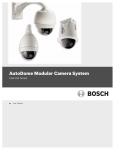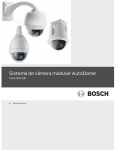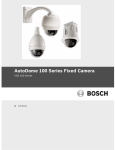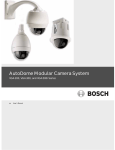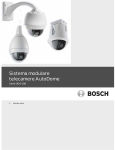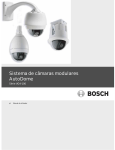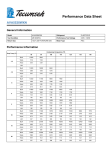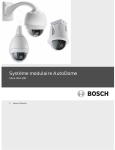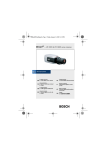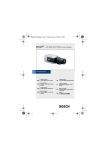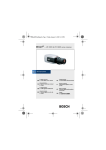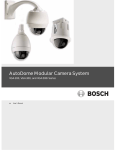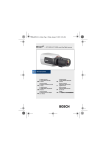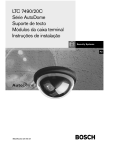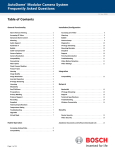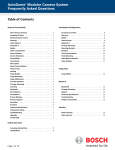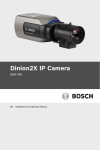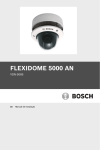Download AutoDome Modular Camera System
Transcript
AutoDome Modular Camera System VG4-100 Series en User’s Manual AutoDome Modular Camera System | en iii Preface This guide describes how to configure and control the VG4-100 Series AutoDome camera. Audience This guide is intended for operators who are familiar with CCTV concepts and configuration. Document Conventions Convention Bold Italic Underline Courier Meaning Denotes a part, item, or assembly. Denotes a reference to another paragraph, figure or table. Used to emphasize a point. Used to denote an item that is selected or must be typed exactly. Symbols You may encounter these symbols within the document. Explanatory text accompanies each symbol, which provides additional information detailing the operation or highlighting safety information. i ! ! NOTICE! Notices inform you of essential but non-critical information. Read these messages carefully as any directions or instructions contained therein can help you avoid making mistakes. CAUTION! Cautionary messages provide critical information that help you reduce the chance of losing data or damaging the system. Please heed these messages. WARNING! Warnings highlight information, that if overlooked may cause damage to the system or result in personal injury. Take warnings seriously. Bosch Security Systems, Inc. VG4-100 Series User’s Manual F01U028033 | 1.0 | 2006.08 iv en | AutoDome Modular Camera System Customer Support and Service If this unit needs service, contact the nearest Bosch Security Systems Service Center for authorization to return and shipping instructions. Service Centers USA Phone: 800-366-2283 or 585-340-4162 Fax: 800-366-1329 Email: [email protected] CCTV Spare Parts Phone: 800-894-5215 or 408-957-3065 Fax: 408-935-5938 Email: [email protected] Canada Phone: 514-738-2434 Fax: 514-738-8480 Europe, Middle East & Asia Pacific Region Phone: 44 (0) 1495 274558 Fax: 44 (0) 1495 274280 Email: [email protected] For additional information, see www.boschsecurity.com Related Publications Refer to the latest Bosch Security Systems Databook for the most up-to-date datasheets. To obtain a copy of the Databook, please contact your local Bosch representative. You can also visit the Bosch Security Systems World Wide Web site at: http://www.boschsecurity.com to view a current listings of our publications. F01U028033 | 1.0 | 2006.08 VG4-100 Series User’s Manual Bosch Security Systems, Inc. AutoDome Modular Camera System Table of Contents | en v Table of Contents 1 Getting Started 3 2 Camera Setup 3 3 Positioning the Camera 4 4 Adjusting Focal Length (Zoom) and Focus 5 5 Advanced Setup 5 5.1 Accessing and Navigating Menus 6 5.2 Main Menu Functions 7 5.3 Install Menu Functions 12 6 Configuring the VG4-100 Series IP AutoDome 14 6.1 Overview of Functions 14 6.2 System Requirements 15 6.3 Connecting the IP AutoDome to the PC 15 6.4 Configuring the IP Camera 16 6.4.1 Installing the Required Software 16 6.4.2 Changing Network Settings 17 6.5 Viewing Live Images 19 6.5.1 Establishing a Connection 19 6.5.2 Configuring Data Streams 19 7 Trouble Shooting Guide 20 8 Glossary of CCTV Terms 23 Index 33 Bosch Security Systems, Inc. VG4-100 Series User’s Manual F01U028033 | 1.0 | 2006.08 vi en | Table of Contents F01U028033 | 1.0 | 2006.08 AutoDome Modular Camera System VG4-100 Series User’s Manual Bosch Security Systems, Inc. AutoDome Modular Camera System 1 Getting Started | en 3 Getting Started Install and wire the 100 Series AutoDome according to the AutoDome Modular Camera System Installation Manual. A typical system includes a keyboard, matrix switcher, monitor, and appropriate wiring connections. Please refer to the individual product manuals for complete installation and setup instructions for each of the system components. 2 Camera Setup To assist setup, the VG4-100 Series camera module can be connected to a monitor through the miniature 2.5 mm monitor jack located on the camera circuit board. The monitor jack provides a composite video signal with synchronization. An optional cable (part number S1460, SAP No. F01U500418) is available for making this connection. To access the monitor jack, remove the bubble and covert liner: 1. Insert a small screw driver through the keyway in the Pendant trim-ring, rotate the dome bubble counterclockwise and remove the dome bubble. For In-Ceiling AutoDomes, you must loosen the small screw in the trim ring before rotating the bubble. 2. Press and hold the two retention buttons on each side of the camera module and then pull off the covert liner. See Figure 2.1 below. Removing the covert liner provides access to the menu keys, and the pan and tilt thumbscrew adjustment locks. See Figure 3.1 on page 4. Retention Buttons (2) Menu Keyboard Monitor Jack BACK VIEW Covert Liner FRONT VIEW Fig. 2.1 100 Series Camera Module Bosch Security Systems, Inc. VG4-100 Series User’s Manual F01U028033 | 1.0 | 2006.08 4 en | Positioning the Camera 3 AutoDome Modular Camera System Positioning the Camera The camera module position can be adjusted along the horizontal, vertical, and diagonal (for azimuth) axes. When adjusting the position, ensure that the picture displayed on the monitor is level. After the covert liner is removed, position the camera by performing the following steps: ! WARNING! To prevent damage to the camera module do not rotate the camera past its stops. 1. For horizontal (pan) adjustment, loosen the thumbscrew at the platform base and rotate the camera (left or right) to the desired position. The camera can be rotated up to 360º between stops. If it hits the stop before achieving the desired position, rotate it in the opposite direction. Retighten the thumbscrew to secure the camera. 2. For vertical adjustment (tilt), loosen the thumbscrew at the tilt wheel and position the camera (up or down) to the desired position. The camera can be tilted up to 110º between stops. Retighten the thumbscrew to secure the camera. 3. To compensate for angled ceilings or sidewall mounts, push the camera inward toward its base and rotate it until the image on the monitor is horizontal. The camera can be rotated up to 300º between stops. CAUTION! The CCD image sensors are highly sensitive and require special care for proper ! performance and extended lifetime. Do not expose it to direct sunlight or bright spotlights in operating and non-operation conditions. Avoid bright lights in the field of view of the camera. Camera Module Camera Module Lock Tab Lock Tab (1) (1) Horizontal (pan) Horizontal (pan) Thumbscrew Thumbscrew (2) (2) Tilt Wheel Tilt Wheel Thumbscrew Thumbscrew (3) (3) Diagonal Adj. Diagonal Adj. Fig. 3.1 F01U028033 | 1.0 | 2006.08 Camera Position Adjustments VG4-100 Series User’s Manual Bosch Security Systems, Inc. AutoDome Modular Camera System 4 Adjusting Focal Length (Zoom) and Focus | en 5 Adjusting Focal Length (Zoom) and Focus To adjust the camera lens focal length and focus, perform the following steps: 1. Select Set Focus Now from the Install menu. 2. To adjust the focal length, loosen the focal (zoom) lock screw and rotate the lens mechanism (WIDE or TELE.) until you achieve the desired field of view. See Figure 4.1below. 3. To focus the image on the monitor, loosen the focus lock screw and turn the lens mechanism (NEAR or FAR) until the image is in focus. 4. Repeat both these adjustments until the desired view is in focus. 5. Tighten both adjustment screws. 6. Exit the Install menu. 7. Remove the monitor jack and replace the covert liner and dome bubble when finished. Focus &Focus Zoom and Zoom Lock Screws Lock Screws Fig. 4.1 Focus and Zoom Adjustment 5 Advanced Setup The VG4-100 Series camera module normally provides an optimal picture without the need for further adjustments. Advanced setup options, however, are available for obtaining the best results from the camera under special circumstances. There are two upper level On-Screen Display (OSD) menus: the Main menu and the Install menu. The Main menu allows you to select and setup the picture enhancement functions. The Install menu allows you to set the camera ID, focus and synchronization settings. The Main and Install menus have settings that you can select directly or open to submenus for a more detailed setup. i NOTICE! Active menu selections can vary depending or the combination of camera, CPU and COMM (communication) modules used. The menu selections described in this manual are typical for a VG4-100 Series system. Bosch Security Systems, Inc. VG4-100 Series User’s Manual F01U028033 | 1.0 | 2006.08 6 en | Advanced Setup 5.1 AutoDome Modular Camera System Accessing and Navigating Menus There are five (5) keys used for navigating through the various menus. To access the setup menus, press the center Select key to open and display the Main menu. Use the four directional keys to navigate through the menus. UP LEFT RIGHT DOWN SELECT MenuKeyboard Keyboard Menu Monitor Jack Monitor Jack Fig. 5.1 Menu Keyboard and Monitor Jack Use the menu keys to perform the following: – To access the Main menu or to select a sub-menu item, press the center Menu Select – To open the Install menu press the Menu Select key for approximately 1.5 seconds. key. – To scroll up or down a menu press the Up or Down keys. – To move through options or to set parameters, press the Left or Right keys. NOTICE! To restore a selected menu item to its factory default, quickly press the Menu i Select key twice. To exit the OSD menus from any menu item, hold down the Menu Select key until the OSD disappears. The VG4-100 Series also supports a variety of remote methods to make camera adjustments, including the following: – A Universal keyboard using Bilinx over coax or UTP. For example, using a Bosch DiBos 8, a Bilinx capable DIVAR, or an Allegiant system. – A PC running the optional Bosch Configuration Tool for Imaging Devices (CTFID) software with a USB Bilinx adapter (Part No. VP-CFGSFT). – i A PC connected to a TCP/IP network with an optional AutoDome IP module installed. NOTICE! To prevent unauthorized changes to the camera settings, the camera menu buttons can be disabled using Bilinx communication through the CTFID software. Select the OnLine Config button, then select the Miscellaneous branch and set Camera Buttons to Disable. F01U028033 | 1.0 | 2006.08 VG4-100 Series User’s Manual Bosch Security Systems, Inc. AutoDome Modular Camera System 5.2 Advanced Setup | en 7 Main Menu Functions This section provides a graphical representation of the Main menu and descriptions for all functions. MAIN Menu ALC ALC ENHANCE ALC LEVEL COLOR SHUTGAIN SHUTGAIN BLC PEAK AVERAGE SHUTTER EXIT ALC SPEED DEFSHUT EXIT SENSUP GAIN ENHANCED MAXGAIN AUTO BLACK DAY/NIGHT1 DAY/NIGHT SHARPNESS EXIT DAY/NIGHT DNR SWITCH LVL XF-DYN PRIORITY EXIT IR CONTRAST MONO BURST COLOR EXIT WHITE BALANCE WB SPEED RED (GAIN) GREEN2 BLUE (GAIN) SAT EXIT BLC BLC BLC LEVEL BLC AREA AREA EXIT 1 Available in Day/Night version cameras only, other versions show NightSense. 2 Only available when White Balance is set to Manual mode. Bosch Security Systems, Inc. VG4-100 Series User’s Manual F01U028033 | 1.0 | 2006.08 8 en | Advanced Setup AutoDome Modular Camera System MAIN Menu Function Selection(s) Description ALC Selects submenu Accesses the Auto Level Control menu. ENHANCE Selects submenu Accesses the Picture Enhancement menu. COLOR Selects submenu Accesses the Color Control menu. BLC ON, OFF, – Enables Back Light Compensation (BLC). or selects submenu – Accesses the BLC submenu. EXIT ALC Submenu Function Exits this menu. Selection(s) Description ALC LEVEL (-15 to +15) Adjusts the video output level. SHUTGAIN Selects submenu Accesses the Shutter and Gain control menu. PEAK AVERAGE (-15 to +15) Adjusts the balance between peak and average video control. ALC SPEED Slow, Medium, Fast EXIT Returns to the MAIN menu. ALC>SHUTGAIN Submenu Function Selection(s) SHUTTER Adjusts the speed of the video level control loop. AES, FL, FIXED Description – AES (Auto Electronic Shutter): The camera automatically sets the optimum shutter speed. – FL (Flickerless): Avoids interference from light sources. – FIXED: Allows the user to define the shutter speed. DEFSHUT FIXSHUT 1/60 (1/50), 1/100, The camera tries to maintain the selected shutter 1/120, 1/250, 1/500, speed as long as the light level of the scene per- 1/1000, 1/2000, 1/5000, mits. 1/10K (Only available if SHUTTER is set to AES mode.) 1/60 (1/50), 1/100, Selects the shutter speed. 1/120, 1/250, 1/500, (Only available if SHUTTER is set to FIXED 1/1000, 1/2000, 1/5000, mode.) 1/10K SENSUP OFF or (2x to 10x) Selects the sensitivity factor the camera is set to. (Only available if SHUTTER is set to AES mode.) GAIN AGC, FIXED – AGC mode: The camera automatically sets the gain to the lowest possible value needed to maintain a good picture. – FIXED mode: The gain is set at a predefined value. MAXGAIN (0 to 26) Selects the maximum value the gain can have during AGC operation. FIXGAIN (0 to 26) Selects the gain setting. (Only available if GAIN is set to FIXED mode.) F01U028033 | 1.0 | 2006.08 VG4-100 Series User’s Manual Bosch Security Systems, Inc. AutoDome Modular Camera System Advanced Setup | en Function DAY/NIGHT 3 NIGHTSENSE Selection(s) Description Selects submenu Accesses the Day/Night Control menu. AUTO, OFF, FORCED – 9 AUTO mode: Camera automatically switches to NIGHTSENSE in low light conditions. – OFF mode: NIGHTSENSE is turned off. – FORCED mode: The camera is set to NIGHTSENSE (black and white) mode EXIT 3 i Returns to the ALC menu. Only available in Day/Night version cameras, color versions show NightSense. NOTICE! If SensUp is active, some noise or spots may appear in the picture. This behavior is normal. SensUp may cause some motion blur on moving objects. Depending on the camera GAIN setting, unrelated menu items are not active. ALC > SHUTGAIN > DAY/NIGHT Submenu Function Selection(s) DAY/NIGHT AUTO, COLOR, MONO Description – AUTO: Switches the filter between COLOR and MONO depending on the scene illumination level. – COLOR: Use for normal daylight conditions. – MONO: Removes the IR filter, providing full IR sensitivity. SWITCH LEVEL (-15 to +15) Sets the video leveling threshold when the camera switches to monochrome operation. PRIORITY COLOR, MOTION In AUTO mode: – COLOR: Displays a color image as long as the light level permits. – MOTION: Avoids motion blur as long as the light level permits. IR CONTRAST NORMAL, ENHANCED – NORMAL: Optimizes contrast in monochrome applications with visible light illumination. – ENHANCED: Optimizes contrast in applications with high IR illumination levels. MONO BURST ON, OFF – ON: The color burst remains active, even in Monochrome mode. – OFF: The color burst in the video signal is switched OFF in Monochrome mode. EXIT i Returns to the SHUTGAIN menu. NOTICE! Depending on the camera’s DAY/NIGHT setting, unrelated menu items are not active. Bosch Security Systems, Inc. VG4-100 Series User’s Manual F01U028033 | 1.0 | 2006.08 10 en | Advanced Setup AutoDome Modular Camera System ENHANCED Submenu Function Selection(s) AUTO BLACK ON, OFF Description ON: Automatically increases the visibility of details. SHARPNESS (-15 to +15) Adjusts the sharpness of the picture. Zero (0) is the default position. DNR AUTO, OFF AUTO: Automatically reduces the noise in the (dynamic noise picture. This option may cause some motion blur reduction) with moving objects. OFF: DNR is turned off. XF-DYN OFF, LOW, MID, HIGH XF-DYN mode: Automatically optimizes picture contrast. EXIT Returns to the MAIN menu. COLOR Submenu Function Selection(s) WHITE BALANCE ATW, AWB HOLD, Description – MANUAL ATW (Automatic White Balance): Allows the camera to constantly adjust for optimal color reproduction. – AWB HOLD: Puts the ATW on hold and saves the color settings. – MANUAL: Allows the red, green and blue gain to be set manually to a desired position. WB SPEED Slow, Medium, Fast Adjusts the speed of the white balance control RED-GAIN (-5 to +5) – In ATW mode: Adjusts the red gain to opti- RED (-30 to +30) – In Manual mode: Adjusts red gain. GREEN (-5 to +5) In Manual mode: Adjusts the green gain. loop when in ATW mode. mize white. (Not available in ATW mode.) BLUE-GAIN (-5 to +5) – In ATW mode: Adjusts the blue gain to opti- BLUE (-30 to +30) – In Manual mode: Adjusts the blue gain. SAT (-15 to +5) Adjusts the color saturation. mize white. (-15 produces a monochrome picture.) EXIT F01U028033 | 1.0 | 2006.08 Returns to the MAIN menu. VG4-100 Series User’s Manual Bosch Security Systems, Inc. AutoDome Modular Camera System Advanced Setup | en 11 Back Light Compensation (BLC) Submenu Function Selection(s) Description BLC ON, OFF ON: The video level optimizes the selected area of the image. Parts outside this area may be underexposed or overexposed, which is normal. BLC LEVEL (-15 to +15) Adjusts the balance between the selected BLC area and its surroundings. BLC AREA Selects submenu Accesses the Back Light Compensation area menu. To size the BLC area: 1. Select the AREA option from the BLC menu. The monitor displays the current area with the upper left corner flashing. 2. Move the flashing corner of the image by using the Up, Down, Left and Right keys to change the size and shape of the area. 3. Press the center Menu Select key to move the flashing cursor to the opposite (or diagonal) corner, which can now be used to change the size and shape of the area. 4. Press the Menu Select key again to save the area and to exit the AREA menu. EXIT Bosch Security Systems, Inc. Returns to the MAIN menu. VG4-100 Series User’s Manual F01U028033 | 1.0 | 2006.08 12 en | Advanced Setup 5.3 AutoDome Modular Camera System Install Menu Functions This section provides a graphical representation of the Install menu and descriptions for all functions. Install Menu INSTALL Menu CAMERA ID SET FOCUS NOW INSTALL CAMERA ID COMM CAMERA ID SYNC ID POSITION DEFAULTS EXIT EXIT INSTALL SYNC SYNC VPHASE EXIT INSTALL DEFAULTS RESTORE ALL? EXIT INSTALL Menu Function CAMERA ID Selection(s) Description Selects submenu Accesses the Camera ID submenu. SET FOCUS NOW Completely opens the lens iris for best focus. The recommended focus procedure is: 1. 2. Unlock the focus locking screw. From the INSTALL menu highlight SET FOCUS NOW. COMM ON, OFF 3. Turn the lens focus adjustment as required. 4. Tighten the lens focus locking screw. 5. Exit the menu selection. Turns on Bilinx communication. See notice below. SYNC Selects submenu DEFAULTS Selects submenu Accesses the synchronization functions. Returns all settings for all modes to their default. EXIT i Exits this menu. NOTICE! When using Bilinx control, the COMM ON/OFF menu selection is not active. This function can be accessed only through the camera menu keys when the CTFID software is not actively running. F01U028033 | 1.0 | 2006.08 VG4-100 Series User’s Manual Bosch Security Systems, Inc. AutoDome Modular Camera System Advanced Setup | en CAMERA ID Submenu Function Selection(s) CAMERA ID Selects submenu 13 Description To enter up to a 17-character camera name: 1. Press the Menu Select key to enter the Camera ID string. 2. Enter up to a 17-character string name for the camera. 3. Use the Up and Down keys to select a charac- 4. Use the Left and Right keys to change ter. position in the string. 5. Press the Menu Select key to save and to 6. Exit the Camera ID menu. exit the character string. ID POS OFF, TOP, BOT Use left or right keys to select: OFF: Camera ID not displayed. TOP: Camera ID displayed at upper left corner of display. BOT: Camera ID displayed at lower left corner of display. (The camera ID is not displayed when the OSD menu is open.) EXIT Returns to the INSTALL menu. SYNC Submenu Function Selection(s) SYNC INTERNAL, LINE LOCK Description INTERNAL: Synchronizes the camera to an internal crystal. (default) LINE LOCK: Synchronizes the camera to AC power and eliminates picture roll in multi-camera systems. VPHASE (0º to 358º) Adjusts the vertical phase offset in LINE LOCK mode. (Only active if a valid power supply frequency is detected.) Exit Returns to the INSTALL menu. DEFAULTS Submenu Function Selection(s) RESTORE ALL? NO, YES Description Use the left or right keys to select: NO: To not change settings. YES: To restore all defaults. You receive a confirmation message. Exit Bosch Security Systems, Inc. Returns to the INSTALL menu. VG4-100 Series User’s Manual F01U028033 | 1.0 | 2006.08 14 6 en | Configuring the VG4-100 Series IP AutoDome AutoDome Modular Camera System Configuring the VG4-100 Series IP AutoDome The VG4-100 Series AutoDome can be ordered with an optional IP module that allows the AutoDome to transmit images over a TCP/IP network. It also allows users to configure the camera display settings, camera operating settings, and to configure the network parameters. The VG4-100 Series IP AutoDome incorporates a network video server in the IP module. The primary function of the server is to encode video (and control data) for transmission over a TCP/IP network. With its MPEG-4 encoding, it is ideally suited for IP communication and for remote access to digital video recorders and multiplexers. The use of existing networks means that integration with CCTV systems or local networks can be achieved quickly and easily. Video images from a single camera can be simultaneously received on several receivers. 6.1 Overview of Functions The IP module adds the following functionality to a VG4-100 Series system: Function Description Receiver You can use an MPEG-4 compatible hardware decoder (for example the VIP XD) as a receiver. Computers with decoding software such as VIDOS or computers with the Microsoft Internet Explorer Web browser installed can also receive video images. Video encoding The camera uses the MPEG-4 compression standard and ensures that the data rate remains low even with high image quality and can also be adapted to local conditions within wide limits. Dual Streaming Encodes dual data streams simultaneously according to two individually customized profiles. This feature creates two (2) data streams per camera that can serve different purposes. For example, one (1) data stream for local recording and one (1) data stream optimized for transmission over the Local Area Network (LAN). Multicast Enables simultaneous, real-time transmission to multiple receivers. The network must implement the UDP and IGMP V2 protocols as a prerequisite for Multicasting. Configuration You can configure all camera settings from a Web browser connected to the local network (Intranet) or connected to the Internet. You can also update the firmware, load device configurations, store configuration settings, and copy these settings from one camera to another. Snapshots Allows you to take and store individual video frames as JPEG images from the Web browser interface. Backup You can save video images as a file on a computer’s hard drive from the Web browser interface. F01U028033 | 1.0 | 2006.08 VG4-100 Series User’s Manual Bosch Security Systems, Inc. AutoDome Modular Camera System 6.2 Configuring the VG4-100 Series IP AutoDome | en 15 System Requirements The VG4-100 Series IP AutoDome requires specific software or hardware to allow a user to view live images and to configure camera settings over a TCP/IP network. These requirements are: – A computer with the Microsoft Windows 2000 or XP operating system, network access, – A computer with Microsoft Windows 2000 or XP operating system, network access, and and the Microsoft Internet Explorer Web browser version 6.0 or later, or reception software such as the Bosch VIDOS software or Bosch Dibos 8.0. (See www.boschsecurity.com for more information about Bosch software and hardware for IP cameras), or – An MPEG-4 compatible hardware decoder from Bosch Security Systems (such as the VIP XD) as a receiver and a connected video monitor. (See www.boschsecurity.com for more information about Bosch software and hardware for IP cameras). If you choose to use a computer running Microsoft Internet Explorer or any of the Bosch software, the computer must conform to the following minimum requirements: i 6.3 – Processor: 1.8 GHz Pentium IV – RAM: 256 MB – Video system: 128 MB video memory, 1024x768 display with a minimum of 16-bit color – Network interface: 100-BaseT – DirectX: 9.0c – Microsoft Internet Explorer, version 6.0 or higher – Bosch MPEG ActiveX utility – Java Virtual Machine (supplied) NOTICE! Ensure that the graphics card is set to 16-bit or 32-bit color. If you need further assistance, contact your PC system administrator. Connecting the IP AutoDome to the PC 1. Install the IP AutoDome according to the instructions in the Modular AutoDome Camera System Installation Manual. 2. Connect an Ethernet cable from the IP AutoDome RJ45 connector to a dedicated network 3. Connect the dedicated network switch to the RJ45 connector on the PC . (See option A switch to bypass the Local Area Network (LAN). below.) i NOTICE! The IP AutoDome can also be connected directly to a PC using an Ethernet crossover cable with RJ45 connectors. (See option B below.) Bosch Security Systems, Inc. VG4-100 Series User’s Manual F01U028033 | 1.0 | 2006.08 16 en | Configuring the VG4-100 Series IP AutoDome AutoDome Modular Camera System A IP AutoDome IP Net Switch PC B IP AutoDome Fig. 6.1 6.4 PC AutoDome IP System Configuration Configuring the IP Camera To operate the camera in your network you must assign it a valid network IP address. The default IP address is 192.168.0.1, but you may have to change this address if it conflicts with another device on your network. To properly configure the camera for your network, you need the following information: – Unit IP address: An identifier for the camera on a TCP/IP network. For example, – Subnet mask: A mask used to determine what subnet an IP address belongs to. – Gateway IP address: A node on a network that serves as an entrance to another network. – Port: An endpoint to a logical connection in TCP/IP and UDP networks. The port number 140.10.2.110 is a valid syntax for an IP address. identifies the use of the port for use through a firewall connection. i NOTICE! Ensure that the network parameters of your cameras are available before you begin configuration. The IP AutoDome defaults are as follows: 6.4.1 – IP Address: 192.168.0.1 – Subnet Mask: 255.255. 255.0 – Gateway IP Address: 0.0.0.0 Installing the Required Software To view live video, you must install Bosch MPEG ActiveX, DirectX, and Java Virtual Machine. To install the software do the following: 1. Insert the IP AutoDome software CD into the CD-ROM drive of the computer. 2. Click the Windows Start button, select Run, and then Browse to the CD drive. 3. Open the Install folder, then the MPEG_ActiveX folder and double click on the MPEGAx.exe file. Follow the on-screen instructions to install the Bosch MPEG ActiveX. 4. Open the Tools folder, the DirectX9 folder, and then the DirectX9.0c folder and double-click on the dxsetup.exe file. Follow the on-screen instructions to install DirectX. 5. Open the Tools folder, then the Java VM folder and double click on the executable file. Follow the on-screen instructions to install Java. F01U028033 | 1.0 | 2006.08 VG4-100 Series User’s Manual Bosch Security Systems, Inc. AutoDome Modular Camera System 6.4.2 Configuring the VG4-100 Series IP AutoDome | en 17 Changing Network Settings The IP Module has a default IP address of 192.168.0.1. To change the IP address or any network settings, you can use the Configuration Manager software supplied on the CD or the AutoDome IP Web Server. i NOTICE! Contact your local network administrator for a valid IP address, Subnet Mask, and a Gateway IP Address. Using Configuration Manager Configuration Manager is an optional network utility provided on the AutoDome CD. To install the Configuration Manager software: 1. Browse to the CD and double click on the executable file. Follow the on-screen instruc- 2. Use the Configuration Manager Manual provided in the Documentation folder on the CD tions to install Configuration Manager and .NET Framework if required. to make any configuration changes. Using the AutoDome IP Web Server The VG4-100 Series IP AutoDome incorporates a network video server in the IP module. To configure the camera using the AutoDome IP web server: i NOTICE! Depending on the PC network security settings, the user may have to add the new IP address to the browser’s “trusted sites” list for the browser controls to operate. 1. Set the IP address on the PC to 192.168.0.10 to ensure that the PC and the IP AutoDome are on the same Subnet. 2. Launch Microsoft Internet Explorer and navigate to the following URL: http://192.168.0.1. The Web browser opens the Livepage for the IP AutoDome and you receive a security warning message. 3. Check the Always Trust box; then select YES. 4. Click the Settings link, located at the top of the Livepage. 5. Click the Service Settings link, located in the left pane of the Settings page. 6. Click the Network link to open the Network Settings page. Bosch Security Systems, Inc. VG4-100 Series User’s Manual F01U028033 | 1.0 | 2006.08 18 en | Configuring the VG4-100 Series IP AutoDome Fig. 6.2 7. AutoDome Modular Camera System Network Settings Page Configure the settings on this page based on the addresses provided by your local network administrator. i NOTICE! Click on the Help on this page? link if you need more information. 8. Click the Set button to save the settings. 9. Launch another instance of Microsoft Internet Explorer. 10. Type the original IP address followed by /reset (for example, http://192.168.0.1/reset) in the address bar and click Go to restart the IP AutoDome. Once you restart the IP AutoDome, use the new IP Address to access the Livepage. 11. Disconnect the IP AutoDome Ethernet cable from the dedicated network switch and reconnect the Ethernet cable to the local area network (LAN). F01U028033 | 1.0 | 2006.08 VG4-100 Series User’s Manual Bosch Security Systems, Inc. AutoDome Modular Camera System 6.5 Configuring the VG4-100 Series IP AutoDome | en 19 Viewing Live Images Once the the network cables are properly connected and the IP AutoDome has a valid IP address, you can view live images over the TCP/IP network using Microsoft Internet Explorer. 6.5.1 Establishing a Connection Once all the required software is installed on your local computer and the IP AutoDome is configured with the proper IP addresses, you can connect to the camera using Microsoft Internet Explorer. 1. Launch Microsoft Internet Explorer. 2. Type the IP address of the IP AutoDome into the browser's Address Bar and click Go. 3. If the AutoDome is password-protected, the system prompts you to enter a password. 4. Type the user name and the associated password in the appropriate fields. 5. Click OK to open the IP AutoDome Livepage. The Livepage displays the video image from the camera. i 6.5.2 NOTICE! The IP AutoDome allows a maximum of five (5) standard connections and 25 multicast connections. If you cannot connect to the AutoDome, you may have exceeded the maximum number of connections for the device or network configuration. Configuring Data Streams The IP AutoDome encodes dual data streams simultaneously according to two individually customized profiles. This feature creates two (2) data streams per camera that can serve different purposes. For example, one (1) data stream for local recording and one (1) data stream optimized for transmission over the Local Area Network (LAN). In addition, the camera offers a Motion JPEG (M-JPEG) option. M-JPEG is a video format that uses JPEG picture compression in each frame of the video. Click either the MPEG-4 Stream 1, MPEG-4 Stream 2 or M-JPEG tab to switch between the different displays for the camera image. Bosch Security Systems, Inc. VG4-100 Series User’s Manual F01U028033 | 1.0 | 2006.08 20 en | Trouble Shooting Guide 7 AutoDome Modular Camera System Trouble Shooting Guide Problem Solution No video If using a Bosch G4 Pendant Power Supply Box: 1. Check that the Green LED in the Power Supply Box is on. This LED indicates mains power through the transformer. If the Green LED is off, then: 2. Check the FX101 fuse for mains power to the Power Supply Box. 3. Check the FX102 fuse for 24 V power to the AutoDome Pendant. If O.K., then: If O.K., then: If using a non-Bosch power supply: 4. Check that the mains power to the Power Supply Box is on. 5. Check that there is 24 V output from the transformer. If O.K., then: If O.K., then: 6. Confirm that the power supply meets the Bosch AutoDome power ratings. See the AutoDome Datasheet for specifications. If O.K., then: 7. Check the connector on top of the AutoDome housing for bent pins. If O.K., then: 8. Check the integrity of all wires and terminal connections to the AutoDome. If O.K., then: If there is power to the AutoDome, then: 9. Remove the camera and CPU modules from the AutoDome housing and check that the Green LED on the housing power supply board is on. If the Green LED is off, then: 10. Check that the fuse on the housing power supply board is good. (Try replacing the unit, if an extra camera module is available.) Local Keys Disabled 1. This message appears if the Camera Menu Keyboard has been disabled through the CTFID tool. Select OnLine Config>Installer Options>Miscellaneous>Camera Buttons>Disable. No remote menu 1. access The 100 Series AutoDome utilizes either Bilinx or optional TCP/IP for remote menu access. 2. Ensure that all coax, fiber and Ethernet cables are properly connected. See the AutoDome Modular Camera System Installation Manual. If O.K., then: 3. Check if you can access the AutoDome OSD menus. If O.K., then: If IP AutoDome, then: 4. Ensure that the network settings are properly set for the LAN. See Section 1: Configuring the VG4-100 Series IP AutoDome. Intermittent remote menu access F01U028033 | 1.0 | 2006.08 1. Check that all wiring meets Bosch recommended standards, specifications and distances. See the AutoDome Modular Camera System Installation Manual. VG4-100 Series User’s Manual Bosch Security Systems, Inc. AutoDome Modular Camera System Picture is dark Trouble Shooting Guide | en 21 1. Check that the Gain Control is set to AGC. 2. Check that the ALC level is set to the appropriate level. 3. Check that the video coax is terminated with 75 Ω only at the head end. (Double ter- If O.K., then: If O.K., then: mination causes dark video.) If O.K., then: 4. Check that the camera lens cover is removed. 5. Check that the maximum coax distance has not been exceeded. See the AutoDome If O.K., then: Modular Camera System Installation Manual. If O.K., then: Colors are not correct 6. Restore all camera settings using the Install Menu. 1. Reset the White Balance to the appropriate selection. 2. Check that the maximum coax distance has not been exceeded. See the AutoDome If O.K., then: Modular Camera System Installation Manual. If O.K., then: 3. Restore the White Balance setting to ATW in the Color Menu. Background is too 1. Turn on backlight compensation (BLC). bright to see subject 2. Adjust the BLC level. 3. Adjust the BLC area. 1. Ensure that the Sync Mode is set to Internal (crystal ). 2. Check that the maximum coax distance has not been exceeded. See the AutoDome Video is rolling, noisy or distorted If O.K., then: Modular Camera System Installation Manual. If O.K., then: 3. Check the integrity of all BNC connectors and splices. Note: Connecting a network cable to the interface board of a non-IP AutoDome causes video distortion. 4. Remove network cable from the interface board RJ-45 connector. Day/Night camera does 1. Check that the Day/Night mode is set to AUTO. not switch automati- If O.K., then: cally when image is 2. Set Gain Control to AGC. dark. Inside of EnviroDome If using a Bosch power supply box: bubble is foggy. 1. Check the FX103 fuse in the Bosch Power Supply Box for power (24 V) to the heater module. If O.K., then: 2. Check all wiring and connector pins to the heater module. If using a non-Bosch power supply, 3. Confirm that the power supply meets the Bosch AutoDome power ratings. See the AutoDome Datasheet for specifications. If O.K., then: 4. Check the mains input line voltage. 5. Check that the maximum wire length from the power supply has not been exceeded. If O.K., then: See the AutoDome Modular Camera System Installation Manual. Bosch Security Systems, Inc. VG4-100 Series User’s Manual F01U028033 | 1.0 | 2006.08 22 en | Trouble Shooting Guide F01U028033 | 1.0 | 2006.08 AutoDome Modular Camera System VG4-100 Series User’s Manual Bosch Security Systems, Inc. AutoDome Modular Camera System 8 Glossary of CCTV Terms | en 23 Glossary of CCTV Terms A Address Each AutoDome has a numerical address in the control system in which it is located. This allows the appropriate dome to be operated. The address may be set locally using the Bilinx Configuration Tool for Imaging Devices (CTFID) or remotely using the Fast Address function (see Fast Address). Advanced Alarm Control (AAC) AutoDome’s flexible and sophisticated alarm management subsystem that allows “rules” to be created that define which input(s) activate one or more outputs (see Alarm Rule). In its most basic form, a rule could define which input(s) should activate which output(s). In a more complex form, a rule can be programmed to take a specific keyboard command (pre-existing or not) and perform a dome function, or any combination of the above. Advanced Diagnostics Bosch’s combination of built-in On Screen Displays (OSD) and status LEDs that are used to check critical camera parameters such as internal temperature, input voltage levels, and network connectivity. This allows a technician to quickly determine the source of problems and ensure that the dome is functioning within correct operating limits. Aperture The size of the opening in the iris, which controls the amount of light that reaches the CCD Sensor. The larger the F-Stop numbers, the less light reaches the sensor. AutoBlack A technique of boosting the video signal level to produce a full amplitude video signal even when the scene contrast is less than full range (glare, fog, mist, etc.). The darkest part of the signal is set to black and the lightest part to white, thus increasing the contrast. AutoDome Fully integrated, high speed, pan/tilt/zoom camera built into a protective dome housing allowing full and continuous 360° coverage of the scene. Auto Focus The lens continuously adjusts to the correct focus automatically for the sharpest picture. AutoIris The lens iris opening is automatically adjusted to allow the correct illumination of the camera sensor. Automatic Gain Control (AGC) The electronics that regulate the gain or amplification of the video signal. AutoPan The camera pans continuously between right and left limit settings. AutoPivot As the camera tilts through the vertical position, the camera is rotated to maintain the correct orientation of the image. AutoPlayback This function records the sequence of movements of the AutoDome PTZ for later playback allowing a set pattern to be repeated automatically. This function is often called Guard Tour. Bosch Security Systems, Inc. VG4-100 Series User’s Manual F01U028033 | 1.0 | 2006.08 24 en | Glossary of CCTV Terms AutoDome Modular Camera System AutoScaling As the camera zooms in to increase the size of objects on the monitor screen, the pan and tilt speeds are reduced so that the relative speed on the screen remains constant for similar joystick control positions. AutoTrack A patented technology that integrates motion detection into the camera allowing tracking of an object and zooming in to optimize size and perspective. Auto White Balance (AWB) A feature that allows a color camera to automatically adjust its output color to give a natural color independent of the lighting used. B Back Light Compensation (BLC) Selectively amplifies parts of the image to compensate for large contrast differences when only a portion of the image is brightly lit (e.g. a person in a sunlit doorway). Balun (Balance Unbalanced) A device that converts a balanced video signal (e.g. as used on twisted pair) line to an unbalanced signal (e.g. as used on coax). In a balanced line, such as twisted pair, both wires are electrically equal. In an unbalanced line such as coax, one line has different electrical properties than the other. Bilinx A communications format that allows remote control, configuration and updates to be performed over the video cable (Coax or Passive UTP). Biphase Pan/Tilt/Zoom protocol for Bosch products. C Cable Category Application and bandwidth rating system for UTP cabling. Categories 1 through 6 are based on EIA/TIA-568-B standards. Category is typically abbreviated CAT. UTP Category 5, 5e, and 6 are used for Ethernet data cabling applications. Ethernet wiring distances are limited to a maximum of 100m (328ft.) when using UTP wiring. Cable Compensation A technology that prevents image degradation caused by signal losses when transmitting video over long cable lengths. CCD Format Indicates the size of the camera sensor used. In general, the larger the sensor, the more sensitive the camera and the better the image quality. The format is quoted in inches, for example 1/4" or 1/3". See Charge Coupled Device (CCD). CCD (Charge Coupled Device) The most common type of solid state image sensor used in CCTV cameras. The sensor converts light energy into electrical signals. CCTV (Closed Circuit TeleVision) A video system that transmits television signals over a closed (non-broadcast) system. F01U028033 | 1.0 | 2006.08 VG4-100 Series User’s Manual Bosch Security Systems, Inc. AutoDome Modular Camera System Glossary of CCTV Terms | en 25 Color Temperature A measure of the relative color of illumination. Most generally used to specify the automatic correction range of a color camera. CTFID (Configuration Tool for Imaging Devices) Bosch software used to configure and update cameras and other remote devices over video cable using Bilinx, and to save them for later use. D Day/Night (IR sensitive) An AutoDome that has normal color operation in situations where there is sufficient illumination (day conditions), but where the sensitivity can be increased when there is little light available (night conditions). This is achieved by removing the infrared cut filter required for good color rendition. The sensitivity can be further enhanced by integrating a number of frames to increase the signal to the noise ratio of the camera. Default Shutter This feature allows the shutter speed to be set to a fast speed to eliminate motion blur and providing detailed and clear image of fast-moving objects while there is sufficient light. When light levels fall and other adjustments have been exhausted, the shutter speed reverts to the standard setting to maintain sensitivity. Digital Image Stabilization See Image Stabilization. DNR (Dynamic Noise Reduction) A digital video processing technique that measures the noise (image artifacts) in the picture and automatically reduces it. E Ethernet The most commonly used local area network (LAN) access method. Ethernet complies with the IEEE 802.3 standard. The Ethernet standard supports 10 Mbps, 100 Mbps and 1000 Mbps (Gigabit) data transmission rates. EnviroDome AutoDome with environmental protection that allows it to be used outdoors in almost any climate. Bosch Security Systems, Inc. VG4-100 Series User’s Manual F01U028033 | 1.0 | 2006.08 26 en | Glossary of CCTV Terms AutoDome Modular Camera System F Fast Address A system for setting the address of the AutoDome remotely from the control system. Fiber Optic Transmission Refers to the transmission of video and/or data via optical fibers. Optical fibers are thin glass strands that are designed for light wave transmission. Video and data are digitized and transformed into a series of light pulses. The use of fiber optics for video and data transmission offers several advantages over sending electrical signals across copper wires. First, light pulses are not affected by random radiation in the environment, and thus their error rate is far lower. Fiber optics span far greater distances without need for repeaters or signal regenerators, and are far more secure as they are more difficult to tap and taps in the line can be detected. Optical fiber also provides enormous bandwidth with a single fiber capable of transmitting trillions of bits per second. There are two primary types of optical fiber; singlemode and multimode. Singlemode fiber is used when large distances must be spanned, typically greater than 2 Km/1.2 miles (see Singlemode). Multimode is typically used to span smaller distances such as the inside of buildings or on small campuses (see Multimode). Field of View The measure of the visible area within the camera’s field of view. The larger the focal length, the smaller the field of view. The smaller the focal length, the wider the field of view. Focal Length The distance from the optical center of the lens to the image of an object located at an infinite distance from the lens. Long focal lengths give a small field of view (e.g. telephoto effect), while short focal lengths give a wide angle view. F-Number The standard measure of the lens aperture, which is the iris diameter, divided by the focal length of the lens. The lower the maximum aperture (or F-Number), the more light that passes through the lens. F-Stop See F-Number. G Gateway Address A node on a network that serves as an entrance to another network. Guard Tour Allows recorded tours with a combined duration of 15 minutes. Recorded tours consist of control commands and can be played back as needed. All camera position information is stored for maximum flexibility (including pan, tilt, zoom, etc.). H Hybrid Streaming The ability to simultaneously stream IP video across a local or wide area network, and CVBS video via coaxial or fiber optic cabling. F01U028033 | 1.0 | 2006.08 VG4-100 Series User’s Manual Bosch Security Systems, Inc. AutoDome Modular Camera System Glossary of CCTV Terms | en 27 I Image Stabilization An algorithm that virtually eliminates camera shake in both the vertical and horizontal axes, resulting in exceptional image clarity. Infrared Illumination Electromagnetic radiation (light) with a longer wavelength than is visible to the naked eye. IR illumination is prominent at dusk and dawn and in incandescent lamps. IR illuminators come in the form of lamps with the appropriate filters, LEDs, or lasers. CCD sensors are less sensitive to IR than visible light, but IR can significantly increase the total illumination level, leading to a much better image at low light levels. IP 66 The IP code (Ingress Protection) indicates the degree of protection provided by enclosures for electrical equipment. The first number indicates protection of internal equipment against the ingress of solid foreign objects. The second number indicates protection of internal equipment against harmful ingress of water. Higher digits refer to higher levels of protection. See also NEMA rating. IP Address The address of a device attached to an IP network. Each device on an IP network must use a unique address. Every IP data packet contains a source address (sender) and a destination address (recipient). Each IP address consists of 32-bits that are arranged into four 8-bit “octets” (x.x.x.x). IP addresses range from 0.0.0.0 to 255.255.255.255. IPS (Images Per Second) A measurement of the rate that pictures are displayed to create a video stream. A rate of 25 IPS (PAL) or 30 IPS (NTSC) is generally considered to be full motion video. IRE (Institute of Radio Engineers) A measurement of video amplitude that divides the area from the bottom of sync to peak white level into 140 equal units. 140 IRE equals 1V peak to peak. The range of active video is 100 IRE. L Lux The International (SI) unit of measurement of the intensity of light. It is equal to the illumination of a surface one meter away from a single candle. Bosch Security Systems, Inc. VG4-100 Series User’s Manual F01U028033 | 1.0 | 2006.08 28 en | Glossary of CCTV Terms AutoDome Modular Camera System M MJPEG Motion JPEG is a digital video encoding standard where each video frame is separately compressed into a JPEG image. Modal Dispersion (or Intermodal Dispersion) A broadening of a waveform over long distances. Modal dispersion occurs in multimode fibers, because light is bounced down different reflective paths (e.g. modes) in the fiber. As the distance increases, the path (mode) begins to spread and the arrival time for the different light rays begins to vary. A large variance (dispersion) increases the chance that the optical receiver may interpret the incoming signals incorrectly. Modal dispersion is a major problem with multimode fibers. MPEG-4 A digital video encoding and compression standard that uses interframe encoding to significantly reduce the size of the video stream being transmitted. With interframe coding, a video sequence is made up of keyframes that contain the entire image. In between the keyframes are delta frames, which are encoded with only the incremental differences. This often provides substantial compression because in many motion sequences, only a small percentage of the pixels are actually different from one frame to another. Multimode Fiber An optical fiber with a larger core (typically 50 or 62.5 microns) than singlemode fiber. The core can be made of plastic or glass fibers and it is the most commonly used fiber for short distances such as LANs. The name multimode comes from the fact that light rays travel down multiple reflective paths (modes) within the fiber. This allows light to enter the core at different angles, making it easier to connect to broader light sources such as LEDs (light emitting diodes). Fiber optic interfaces and multimode fiber-based transmission systems are less expensive than those based on singlemode fiber. However, the use of multiple reflective paths (modes) increases modal dispersion (see Modal Dispersion) and shortens the distances that this type of fiber optic transmission system can span. Multi-Protocol A protocol is a convention or standard that controls or enables the connection, communication, and data transfer between two devices. In PTZ cameras such as the AutoDome, protocol refers to the standard used to control the pan, tilt, and zoom (PTZ) operation of the camera. Since each dome camera manufacturer’s PTZ protocols are unique, multi-protocol support is needed to support third party dome systems. AutoDome cameras support the Pelco “D” and “P” protocols and well as Bosch’s own biphase protocol (See Biphase). F01U028033 | 1.0 | 2006.08 VG4-100 Series User’s Manual Bosch Security Systems, Inc. AutoDome Modular Camera System Glossary of CCTV Terms | en 29 N NEMA (National Electrical Manufacturers Association) Rating Specification standards in reference to the operating environment for a variety of electrical devices. NightSense A method of boosting the sensitivity of high-resolution Bosch color cameras by 9db (a factor of 3) by combining the signal of the color image in a single monochrome picture. NPT (National Pipe Thread) A U.S. standard for tapered threads. NPT sizes measure the nominal inside diameter of the pipe. NPT threads form a seal as the threads compress against each other. O OSD (On-Screen Display) Menus are shown on the display monitor. P Pan Camera movement in the horizontal direction. Pixel The smallest addressable unit on a display screen or bitmapped image. Pre-Position A pre-selected and stored combination of pan, tilt and zoom positions that allow a set view to be recalled. Also known as Preset Shot. Preset Tour A sequence of preset shots combined to provide a pre-programmed tour of the area covered by an AutoDome camera. Pressurized Dry Nitrogen Housing A housing for outdoor applications that protects against smog, humidity, dirt and dust. Privacy Masking The ability to mask out a specific area to prevent it being viewed. Bosch Security Systems, Inc. VG4-100 Series User’s Manual F01U028033 | 1.0 | 2006.08 30 en | Glossary of CCTV Terms AutoDome Modular Camera System R Region of Interest The defining of a specific area within a field of view to be used by the motion detection algorithm to only look for motion within this region. Resolution The measure of the fine detail that can be seen in an image. For analog systems this is typically measured in Television Lines or TVL. The higher the TVL rating, the higher the resolution. RS232/485 A communication interface for third party control and firmware upgrades to the AutoDome products. Rule AutoDome’s alarm management subsystem that uses “if this, do that” rules to perform specific actions when an event occurs. S Sector Blanking The ability to blank out video in any of the 16 pan sectors. Sensitivity A measure of the amount of light required to provide a standard video signal. Sensitivity values are stated in lux or foot-candles. SensUp Increases camera sensitivity by increasing the integration time on the CCD. This is accomplished by integrating the signal from a number of consecutive video frames to reduce signal noise. Singlemode Fiber An optical fiber with a silica (e.g. glass) core with a diameter of less than 10 microns. Used for high-speed transmission over long distances, it provides greater bandwidth than multimode, but its smaller core makes it more difficult to couple the light source. Singlemode fiber optic transmission systems use more expensive laser-based light sources. Spot Focus Activates Auto Focus for three seconds after camera movement. Subnet Mask Subnetting is a method that allows one large network to be broken down into several smaller ones. Depending on the network class (A, B, or C), some number of IP address bits are reserved for the network address (subnet) and some for the host address. For example, Class A addresses use 8 bits for the subnet address and 24 bits for the host portion of the address. Class A subnet masks are denoted 255.0.0.0. Class B addresses (16 bits for both the subnet and host address) use a 255.255.0.0 subnet mask. Class C addresses (8 bits for the subnet and 24 bits for the host address) use a subnet mask of 255.255.255.0. F01U028033 | 1.0 | 2006.08 VG4-100 Series User’s Manual Bosch Security Systems, Inc. AutoDome Modular Camera System Glossary of CCTV Terms | en 31 T TCP/IP (Transmission Control Protocol/Internet Protocol) A communications protocol suite that provides two data transport methods. TCP is a connection-based protocol that ensures that data arrives intact and complete. UDP is a connectionless, best effort protocol that simply sends out packets. UDP is typically used for streaming media, while TCP is used when error-free delivery is required. Tilt Camera movement in the vertical direction. Tri-streaming A Bosch encoding technology that generates two separate MPEG-4 video streams and one MJPEG stream simultaneously. This advanced streaming capability enables the user to tune live viewing and recording requirements independently to meet specific site and enterprise requirements. U UTP (Unshielded Twisted Pair) A variant of twisted pair cabling UTP cable is not surrounded by any shielding. The wires in a twisted pair cable are twisted around each other to minimize interference from the other twisted pairs in the cable. UTP is the primary wire type for telephone usage and the most commonly used type of networking cable. V Virtual Masking A unique Bosch technology that allows for the creation of “invisible” motion masking areas. These invisible masks are similar to privacy zones, but only the AutoDome’s AutoTrack II and Video Motion Detection algorithms can see them. This allows the AutoDome to ignore areas of unwanted motion. VMD (Video Motion Detection) An algorithm for motion detection in which the camera compares the current image with a reference image and counts the number of pixels (see Pixel) that have changed between the two images. An alarm is generated when the number of pixel changes exceeds a userconfigured threshold. X XF-Dynamic A highly accurate 15-bit digital signal processing technology from Bosch that extends the dynamic range of DinionXF cameras to optimally capture the detail in both the high and low light areas of the scene simultaneously, maximizing the information visible in the picture. Z Zoom Changing the effective focal length to allow different fields of view to fill the picture area. Zoom can be optical, where the lens is adjusted, or digital, where a portion of the view selected is magnified electronically. Bosch Security Systems, Inc. VG4-100 Series User’s Manual F01U028033 | 1.0 | 2006.08 32 en | Glossary of CCTV Terms F01U028033 | 1.0 | 2006.08 AutoDome Modular Camera System VG4-100 Series User’s Manual Bosch Security Systems, Inc. AutoDome Modular Camera System Index | en Index Symbols /reset 18 A adjusting camera position 4 focus 5 lens 5 pan 4 tilt 4 AES 8 AGC 8 ALC level 8 option 8 speed option 8 submenu 8 Allegiant system 6 area option 11 ATW 10 mode 10 auto black option 10 auto electronic shutter 8 auto white balance 10 auto white balance hold 10 AutoDome IP /reset 18 controlling 19 gateway address 16 IP address 16 Livepage 17 network settings page 17 port 16 subnet mask 16 system requirements 15 viewing live images 19 AWB hold 10 B back light compensation submenu 11 Bilinx 6, 12 USB adapter 6 BLC option 8 BLC submenu 11 blue gain 10 Bosch MPEG ActiveX 15, 16 C cables coaxial 6 Ethernet 6 UTP 6 camera ID 12, 13 string 13 submenu 13 positioning 4 setup 3 advanced 5 covert liner 3 Bosch Security Systems, Inc. 33 retention button 3 trim ring keyway 3 CCD 4 coaxial cable 6 color burst 9 option 8 saturation 10 submenu 10 COMM module 5 option 12 commands /reset 18 OFF-42-ENTER 21 Configuration Manager 17 Configuration Tool for Imaging Devices 6 configuring IP AutoDome 16 /reset 18 connection 19 data streams 19 Livepage 17 network settings 17 port 16 subnet mask 16 TCP/IP 16 UDP 16 unit IP address 16 network settings 17 Configuring the IP Camera 16 covert liner 3, 4, 5 CPU 5 CTFID 6 D data streams 19 day/night option 9 submenu 9 day/night option 9 defaults option 12 submenu 13 defshut option 8 device configuration configuring IP AutoDome devices 14 DiBos 6, 15 DirectX 15, 16 DIVAR 6 DNR option 10 dome bubble 5 dual streaming 14 dxsetup.exe 16 dynamic noise reduction option 10 VG4-100 Series User’s Manual F01U028033 | 1.0 | 2006.08 34 en | Index E encoding video 14 enhance option 8 enhanced submenu 10 Ethernet 6 cable 15, 18 F files dxsetup.exe 16 JPEG 14 M-JPEG 19 MPEG-4 14, 15 MPEGAx.exe 16 firmware 14 fixed mode 8 fixgain option 8 fixshut option 8 FL 8 flickerless 8 focal length 5 tele 5 wide 5 lock screw 5 focus 5 image far 5 near 5 lock screw 5 forced mode 9 G gain option 8 gateway address 16 green gain 10 H AutoDome Modular Camera System M main menu 5, 6, 7 manual mode 10 maxgain option 8 menu keys down 6, 11 left 6, 11 menu select 6, 11, 13 right 6, 11 up 6, 11 menu select key 6, 11, 13 menus accessing 6 install 5, 6, 8, 12 main 5, 6, 7 navigating 6 Microsoft Internet Explorer 14, 15 M-JPEG 19 M-JPEG option 19 mode ATW 10 fixed 8 forced 9 manual 10 monochrome 9 XF-DYN 10 monitor jack 3 mono burst option 9 monochrome mode 9 MPEG-4 14, 15 stream 1 19 stream 2 19 MPEGActiveX 16 MPEGAx.exe 16 multicast 14 N Java VM 16 JPEG 14 navigation down key 6, 11 left key 6, 11 right key 6, 11 up key 6, 11 network settings page 17 networking Ethernet cable 15 gateway address 16 IGMP V2 14 IP 14 address 16 port 16 subnet mask 16 TCP/IP 14 UDP 14 nightsense option 9 lens 5 mechanism 5 line lock 13 live images 19 Livepage 17, 19 OFF-42-ENTER 21 operating system Windows 2000 15 Windows XP 15 OSD 6 horizontal adjustment 4 I ID position option 13 IGMP V2 14 install menu 5, 6, 8, 12 IP 14 address 16, 17 unit 16 module 6, 14 IR contrast option 9 filter 9 illumination level 9 J L F01U028033 | 1.0 | 2006.08 O VG4-100 Series User’s Manual Bosch Security Systems, Inc. AutoDome Modular Camera System P pan 4 peak average option 8 port 16 positioning camera 4 sidewall mount 4 titled ceiling 4 priority option 9 protocol IGMP V2 14 TCP/IP 14 UDP 14 R red gain 10 restore all option 13 restore defaults 13 retention button 3 Index | en 35 video signal 3 VIDOS 14, 15 viewing live images 19 VIP XD 14, 15 VP-CFGSFT 6 VPHASE option 13 W WB speed 10 white balance 10 option 10 X XF-DYN mode 10 option 10 S SAT option 10 saturation option 10 select key 6 SensUp 9 option 8 set focus now option 12 sharpness option 10 shutgain option 8 submenu 8 shutter option 8 sidewall mount 4 snapshots 14 software Bosch MPEG ActiveX 16 Configuration Tool for Imaging Devices 6 DirectX 15, 16 dxsetup.exe 16 MPEGActiveX 16 MPEGAx.exe 16 Windows 2000 15 Windows XP 15 subnet mask 16 switch level 9 synchronization option 12 submenu 13 T TCP/IP 6, 14 tilt 4 tilt wheel 4 tilted ceiling 4 trim ring keyway 3 U UDP 14 unit IP address 16 universal keyboard 6 USB 6 UTP cable 6 V vertical adjustment 4 Bosch Security Systems, Inc. VG4-100 Series User’s Manual F01U028033 | 1.0 | 2006.08 36 en | Index F01U028033 | 1.0 | 2006.08 AutoDome Modular Camera System VG4-100 Series User’s Manual Bosch Security Systems, Inc. Americas: Bosch Security Systems 130 Perinton Parkway Fairport, New York, 14450 USA Phone +1 800 289 0096 Fax +1 585 223 9180 www.boschsecurity.us © Bosch Security Systems, Inc., 2006 Europe, Middle East, Asia: Bosch Security Systems B.V. Postbus 80002 5600 JB Eindhoven Phone: +31 40 2577 200 Fax: +31 40 2577 202 [email protected] www.boschsecurity.nl www.boschsecurity.com Asia-Pacific: Bosch Security Systems Pte Ltd. 38C Jalan Pemimpin Singapore 577180 Phone +65 6319 3450 Fax +65 63139 3499 www.boschsecurity.com










































